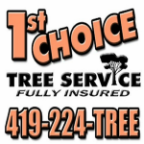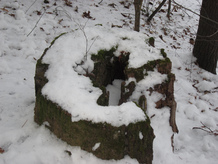Is your tree care provider using spikes to climb while pruning your trees? Ouch!
Climbing spikes are sharpened steel spikes attached to the climber's leg by leather straps and padded supports. These spikes are traumatizing to your living tree and create unnecessary damage.
Each puncture from a climbing spike produces a certain amount of tree tissue death around it to some extent, varying from tree to tree. In most cases isolated wounds will seal, but over time, groupings of spike holes can cause the entire area on the trunk to die back with no chance of recovery.
The likelihood of piercing the cambium (living tissue beneath the bark) is high, even with larger trees and thick bark. If soon after the work is performed with spikes there is sap oozing from the wounds, the tree is responding to spike damage. Repeated damage of this type is harmful to the tree.
So why would climbers use spikes? The use of tree climbing spikes (spurs, hooks, gaff, irons, etc.) is a once-practiced method of climbing trees that has proven to be harmful to long-term tree health. The climber, using one leg at a time, will kick these spikes into the tree tissue and take alternate steps to ascend the tree - similar to climbing a ladder.
There are certain exceptions, when spikes are allowed, such as:
Homeowners searching for qualified tree care companies should look for the following:
A professional can assess your landscape and work with you to determine the best trees and shrubs to plant for your existing landscape.
Climbing spikes are sharpened steel spikes attached to the climber's leg by leather straps and padded supports. These spikes are traumatizing to your living tree and create unnecessary damage.
Each puncture from a climbing spike produces a certain amount of tree tissue death around it to some extent, varying from tree to tree. In most cases isolated wounds will seal, but over time, groupings of spike holes can cause the entire area on the trunk to die back with no chance of recovery.
The likelihood of piercing the cambium (living tissue beneath the bark) is high, even with larger trees and thick bark. If soon after the work is performed with spikes there is sap oozing from the wounds, the tree is responding to spike damage. Repeated damage of this type is harmful to the tree.
So why would climbers use spikes? The use of tree climbing spikes (spurs, hooks, gaff, irons, etc.) is a once-practiced method of climbing trees that has proven to be harmful to long-term tree health. The climber, using one leg at a time, will kick these spikes into the tree tissue and take alternate steps to ascend the tree - similar to climbing a ladder.
There are certain exceptions, when spikes are allowed, such as:
- when the tree is being removed.
- when branches are more than throwline distance apart and there is no other means of climbing the tree (for example: when there are no branches lower than 50 feet), with no access for an aerial lift device or crane.
- if the tree is too close to power lines and cannot be accessed safely by other means.
- to reach an injured climber.
Homeowners searching for qualified tree care companies should look for the following:
- Good References: Ask for references, and check on the quality of their work. Don't be rushed by a bargain and don't pay in advance.
- Proof of Insurance: Ask for current certificates of liability and workers' compensation insurance, if applicable. Be aware that if the tree care company you hire doesn't have insurance or is not a legal company, you - the homeowner - could be held responsible as a contractor.
- Solid Reputation: Verify professional affiliations the company might have, such as memberships in business and/or professional organizations such as the Tree Care Industry Association.
- Up-to-Date Knowledge: Ask if they follow ANSI Standards. A professional arborist will be aware of the current safety, pruning, fertilizing, and cabling standards.
- Contract: Insist on a signed contract as to cost, dates when work is to be performed, and exactly what is to be done. Insist that climbing spikes are used only if the tree is to be cut down.
A professional can assess your landscape and work with you to determine the best trees and shrubs to plant for your existing landscape.


 RSS Feed
RSS Feed